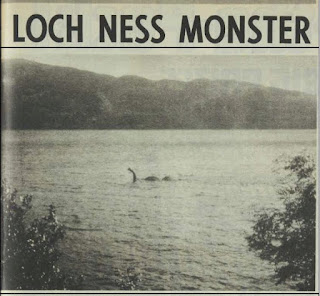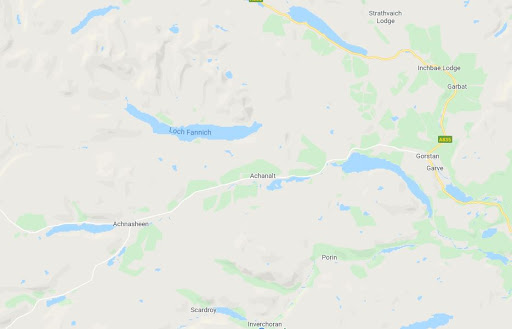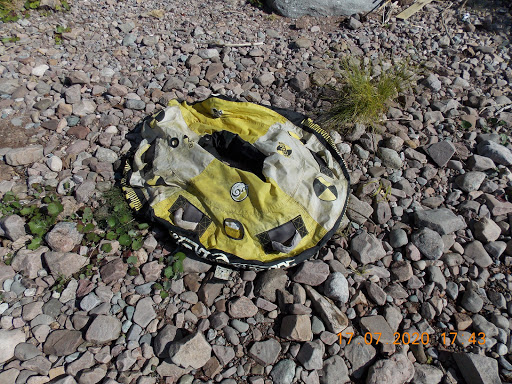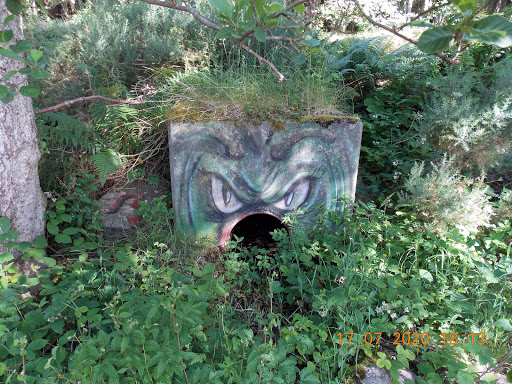Reclaiming the Loch Ness Monster from the current tide of debunking and scepticism. If you believe there is something strange in Loch Ness, read on.
Sunday, 6 September 2020
Possible Nessie Photos from 2005
Thursday, 20 August 2020
The Monsters of Achanalt
Achanalt is a small village on the road between Ullapool and Inverness in the Highland region to the north and west of Loch Ness. It has a nondescript loch amongst other nondescript lochs in this lonely wilderness setting. However, back in 1935, a man by the name of Robert Lawson Cassie (b.1859) came forward with some incredible tales of monsters swimming in these lochs and rivers. The cryptid stories appeared in two books entitled "The Monsters of Achanalt", volumes one and two. These were published in 1935 and 1936, created a minor stir and then disappeared from view as general interest in Scottish loch monsters waned. But first, where is Achanalt on the map of Scotland? The general locality is circled below and is about 40 miles from central Loch Ness.
Zooming into that area reveals various small lochs and lochans and river systems surrounded by general mountainous terrain with a small population. Loch Achanalt (centred in the picture) itself is described as a body of water about three quarters of a mile across and a maximum depth of nine feet. You could walk around the loch in about half an hour. This is no more than a puddle in terms of lochs and would have escaped our notice if Cassie had not taken up his pen. However, other local lochs of various shapes and sizes are included such as Loch Rosque, Loch Crann, Loch Culan, Loch Luichart and Loch Garve.
By dave conner - originally posted to Flickr as Wester Ross - Loch Achanalt
But to give a flavour of what Cassie talked about, I quote two stories about monsters he claimed to have sighted with friends.
A VISIT TO THE WESTERN WATERSHED
On Thursday, August 29, I ordered a motor car from the Achnasheen Hotel. We left the Auld Hoose at 2.30 p.m., and our journey was by Achnasheen Loch Rosque, Loch Crane, past the watershed, the highest point on the Glen Docharty road, and down the brae as far as the vicinity of Kinlochewe, where we finished the outward trip. Our party consisted of Mr., Mrs., and Master MacMahon, Aberdeen; Mrs. Macrae, the Auld Hoose, Achanalt; the chauffeur, and myself. Stoppages were made at convenient points for scrutiny of the rivers and lochs. Creatures of varying sizes were noticed where the river was easily visible. Loch Rosque is about six miles long by half a mile wide. For the greater part of its length it is screened from the road by trees. We stopped twice at gaps in the wood before reaching the west end, where we made a very thorough survey. At the breaks I was able to distinguish at least a dozen of the immature reptiles, mostly about mid-loch, and showing only the briefest glimpses in the rough water. It was impossible to guess at their length. In most cases they escaped the notice of my companions, but experience made them unmistakable to me. Stopping at the western end of the loch, we all saw a number of large reptiles — about six at one time. general trend of their progress was across the loch to the brae of the south shore, where there was a tendency to leave the water at the base of the high hill that rises steeply from the loch. Their probable lengths would be from thirty to fifty feet.
Mr. MacMahon took various photographic exposures under favourable conditions. Proceeding a short distance farther, we left the car when we reached the nearest attainable point to loch Crann. It is a small, roundish, pond-like loch joined to Loch Rosque by a short and narrow stream. Reptiles were seen in this burn, and there were some five longish ones visible in Loch Crann itself. As they were partially submerged, approximate lengths could not be guessed at, but in my considered opinion, fifty feet average would be a safe estimate, perhaps erring on the side of moderation. They were not active, and their poses did not lend themselves well to photography; but Mr. MacMahon took several exposures, including that of a contracted or dinosaur-like pose of an animal seen on the brae, several yards from the bank, at the foot of the southern ben. Here I may interpolate that they seem to be landing in swampy places fairly often. On our return journey we noticed a slender form, a few feet long, motionless on a gravelly spit at a bend in the river. There is an extensive region of dry land at the watershed. For a mile or so we followed the course of a small burn that flows west to Loch Ewe, but it seemed too shallow to be the abode of reptiles. At any rate, no sign of life was observed in it. We saw two small reptiles, however, in the burn that feeds Loch Crann from the west.
EXPLORATION OF THE EASTERN WATERWAY
On Friday, August 30, 1935, we scanned the lower reaches of the waterway as far as the Upper Blackwater - i.e., for some distance along the course of the river, after it leaves Loch Garve. This time the car came from our obliging friend, Mr. D. Mackenzie of the Garve Hotel. The party consisted of Mr. and Mrs. A. W. MacMahon and their young son Michael, Miss Jean Macrae, the Auld Hoose, Achanalt; Mr. Roderick Macrae, chauffeur, Garve Hotel; and myself. We left the Auld Hoose a little before 5p.m.
Loch Achanalt is now very populous, and we had a passing view of some of the creatures in it. From prolonged observations I consider that the northern section of the loch now contains reptiles up to fifty feet in length, while there are many measuring between ten and thirty feet. Their characteristics have been described in previous chapters. The southern or Badluchie side of the loch is nearly shut off by a long tongue of grassy land, leaving only a narrow strait of communication. For several weeks past, dating from a heavy rainstorm and inundation, there have been indubitable signs that the southern loch contains one or more creatures of incredible dimensions.
From the Auld Hoose, a mile or more away, I daily see a long and high "plough furr" crossing the loch from north to south. Any curve of extra length cannot be determined. But it is alive and moving. The humps and elevated ridges along its back cannot be mistaken, and - perhaps from its very length - it behaves very differently from the smaller reptiles, and is far less elusive. It bears a marked general resemblance to pictures of the sea-serpent appearing in the current literature on the subject.
I ought to have inspected this stupendous animal at close range,but I suffer from various disabilities. The walk over rough ground taxes my powers. The river is spanned by a long, swinging bridge with ricketty planks, causing an uncomfortable feeling of tension. Lastly, one has to cross a marsh tenanted by a black bull of uncertain temper. Providence, however, has enabled me to get a very near view of this animal, or his double. On Thursday, August 29, 1935, between 11.30 and 12 noon (the time was not exactly noted) I left home in the company of a witness of unimpeachable credence in every respect. At a distance of about thirty yards we saw the high back of a reptile gliding up the river. Our field of view was somewhat restricted by out-buildings. This creature took quite a number of minutes, moving at a slow rate, to pass our point of observation.
Proceeding to the road giving a complete view of the river between two bends, we saw the animal still slowly coming up. At the bend next us it seemed to dispose of its head and foreparts deeply in the water, under the east bank. I marvelled for some minutes at the manner in which it could be stowing itself away. Suddenly a whirl of numerous flat-topped humps, black or dark in colour, appeared in the nook at the east bank. The creature was turning! The process was a long one, and an elongated shape had lengthened well down the straight section of the river, between the bends, before the reversal was completed. So far as the witness and I could see, the length of the creature was about the distance between the two bends. I estimate this distance at three hundred yards or nine hundred feet. A local friend of great experience confirms my view.
So what are we to make of these fantastical reports? The answer is simple, they are all fabricated nonsense. No one else ever corroborated such reports and, despite being told of various photographs of these creatures being snapped, none of them make it into Cassie's two books. The almost monotonous appearance of these creatures makes them easier to spot than deer and perhaps even sheep. The description at the end of a nine hundred foot serpent struggling to contain itself in a comparable river is surely designed to elicit sceptical reactions in even the most gullible believer.
One of the witnesses was an A. W. MacMahon of Aberdeen who took various photographs. A search of the online newspaper archives does reveal an A. W. MacMahon who ran a photography business in Aberdeen at that time but no mention of monsters. So the co-eyewitnesses likely did exist, but they were just in on the joke. But it has to be asked what made Cassie write such garbage? One clue is in a newspaper clipping from the previous year in which he claims a sighting of the Loch Ness Monster. The headline below is taken from the Aberdeen Press and Journal dated 25th June 1934.
The Aberdeen Press and Journal had published some of Cassie's previous books, so it is no surprise they take up his story. In this story, Cassie is again with a Mrs. MacRae and Mr. Healy, a chauffeur of the Garve Hotel. This report was not in the eyewitness database I use, so it was new to me. An examination of it gave me some doubts about it. The "disporting itself vigorously" involved Cassie's creature taking a sequence of leaps out of the loch in Urquhart Bay near the castle at 45 degree angles to the water revealing a roundish body and ending in a big splash and spray of water. I presume he had the idea of a humped back whale or a dolphin breaching the water as it leaps out.
The reason I have my doubts about this story is because I can find no other account in the stories of 2000+ witnesses that mentions such a breaching action. I therefore conclude the creature does no such thing and Cassie has made the whole story up by overdramatising it. However, his Achanalt stories would already have cast doubt upon anything he would say. Another account of Cassie's stories can be found in an article by Mike Dash in Fortean Times No.177 from 2003. He states that Cassie claims the Achanalt monsters began to appear in June 1934 which is the same time he claimed to have seen Nessie. I suggest this coincidence is no coincidence and rather denotes the time Cassie decided to embark upon his tales of deception.
Why June 1934? Well, stories of the Loch Ness Monster had been steadily rising since the summer of 1933, but Nessie fever was about to peak in July 1934 and news of the monster was just about everywhere all the time. That month of July would prove to be the busiest month right up to the present day for monster reports. As an undoubted sceptic of anything monstrous in any loch, Mr. Cassie must have been quite fed up with the coverage by June and was no doubt convinced anyone could submit a report and be published. With his reputation as a local and respected author, he put that to the test and was proven right.
The resulting mix of satisfaction and disdain he must have gained from that initial toe dip into the media would have emboldened him to expand the story into his basically satirical work on loch monsters in the region of Achanalt. His book was an attack on believers and not sceptics. However, he could not continue his story at Loch Ness as it was too busily watched and so he moved the story to the relative solitude of the hill country of Achanalt where Cassie (pictured below) lived.
So the booklets were published, nobody believed them, but that was not the point, it was Cassie's own personal commentary on the Nessie mania of 1933 to 1934 and his contempt for anyone who genuinely or ungenuinely claimed to have seen them. It's a pity he did not make a better attempt to properly evaluate eyewitness reports. That task was left to his contemporary, Lt. Cmd. Rupert T. Gould. I wonder what he made of Cassie's pack of lies?
The author can be contacted at lochnesskelpie@gmail.com
Thursday, 13 August 2020
Loch Ness and the Scientists
Tuesday, 4 August 2020
Loch Ness Trip Report July 2020



Tuesday, 28 July 2020
Audio Interview on the Famous Nessie Fakers
Wednesday, 22 July 2020
A Recent photo from Loch Ness
Any extra information will be helpful to include/exclude suspects.
UPDATE:
Jeremy emailed with the photo below which he says was taken from the same spot on the 8th May 2019 and says it is a log. Of course, that implies the object is still there over a year later which is not impossible if the water there is shallow enough. A look at the 1903 bathymetric map suggests it is not shallow enough to hold a log captive, so I am not sure of this one.
Wednesday, 8 July 2020
Saint Columba's other Water Monsters
When Cormac was laboriously engaged in his third voyage over the ocean, he was exposed to the most imminent danger of death. For, when for fourteen days in summer, and as many nights, his vessel sailed with full sails before a south wind, in a straight course from land, into the northern regions, his voyage seemed to be extended beyond the limits of human wanderings, and return to be impossible.
Accordingly, after the tenth hour of the fourteenth day, certain dangers of a most formidable and almost insurmountable kind presented themselves. A multitude of loathsome and annoying insects, such as had never been seen before, covered the sea in swarms, and struck the keel and sides, the prow, and stern of the vessel, so very violently, that it seemed as if they would wholly penetrate the leathern covering of the ship. According to the accounts afterwards-given by those who were there, they were about the size of frogs; they could swim, but were not able to fly; their sting was extremely painful, and they crowded upon the handles of the oars.
When Cormac and his fellow-voyagers had seen these and other monsters, which it is not now our province to describe, they were filled with fear and alarm, and, shedding copious tears, they prayed to God, who is a kind and ready helper of those who are in trouble. At that same hour our holy Columba, although far away in body, was present in spirit with Cormac in the ship. Accordingly he gave the signal, and calling the brethren to the oratory, he entered the church, and addressing those who were present, he uttered the following prophecy in his usual manner: "Brethren, pray with all your usual fervour for Cormac, who by sailing too far hath passed the bounds of human enterprise, and is exposed at this moment to dreadful alarm and fright, in the presence of monsters which were never before seen, and are almost indescribable.
We ought, therefore, to sympathize with our brethren and associates who are in such imminent danger, and to pray to the Lord with them; behold at this moment Cormac and his sailors are shedding copious tears. and praying with intense fervency to Christ; let us assist them by our prayers, that God may take compassion upon us, and cause the wind, which for the past fourteen days has blown from the south, to blow from the north, and this north wind will, of course, deliver Cormac's vessel out of all danger."
Now what could these strange beasts be that so assailed the vessel of Cormac? The description of being like frogs or insects which could swim, sting and swarm around the boat suggests these may have been some species of jellyfish. In the right warm conditions, we can have a population explosion which can clog boats and could cause consternation to travelers. The fact this happened in the summer supports such a theory and I note a modern story from the south of Scotland concerning a swarm of common moon jellyfish. But then again, one would have thought they would have known jellyfish when they saw them? Other monsters are mentioned in this story which we are told were beyond the scope of the book. We will never know what kind of encounters these were.
One day when the venerable man was staying in the Iouan island (Iona), a certain brother named Berach intended to sail to the Ethican island (Tiree), and going to the saint in the morning asked his blessing. The saint looking at him, said, "O my son, take very great care this day not to attempt sailing direct over the open sea to the Ethican land (Tiree); but rather take a circuit, and sail round by the smaller islands, for this reason, that thou be not thrown into great terror by a huge monster, and hardly be able to escape." On receiving the saint's blessing he departed, and when he reached his ship, he set sail without giving heed to the saint's words.
But as he was crossing over the larger arms of the Ethican sea, he and the sailors who were with him looked out, and lo, a whale, of huge and amazing size, raised itself like a mountain, and as it floated on the surface, it opened its mouth, which, as it gaped; was bristling with teeth. Then the rowers, hauling in their sail, pulled back in the utmost terror, and had a very narrow escape from the agitation of the waves caused by the motion of the monster; and they were also struck with wonder as they remembered the prophetic words of the saint.
On the morning of that same day, as Baithene was going to sail to the forenamed island, the saint told him about this whale, saying, "Last night, at midnight, a great whale rose from the depth of the sea, and it will coast this day on the surface of the ocean between the Iouan and Ethican islands (Iona and Tiree)." Baithene answered and said, "That beast and I are under the power of God." "Go in peace," said the saint, "thy faith in Christ shall defend thee from this danger." Baithene accordingly, having received the saint's blessing, sailed from the harbour; and after they had sailed a considerable distance, he and his companions saw the whale; and while all the others were much terrified, he alone was without fear, and raising up both his hands, blessed the sea and the whale. At the same moment the enormous brute plunged down under the waves, and never afterwards appeared to them.
The likely two candidates for this beast identified as a whale are the killer whale or a basking shark. The huge gaping mouth described in the story reminds one of the filter feeding action of the basking shark, though it could hardly be described as bristling with teeth. Both creatures are compared below. It is to be noted that Adomnan readily identifies the creature as a whale like everything else in his book apart from the one creature encountered on the River Ness and those strange frog-like creatures north of Iona. I made an educated guess concerning them, what was encountered in the river does not readily fit anything normally seen in that river.
The author can be contacted at lochnesskelpie@gmail.com





